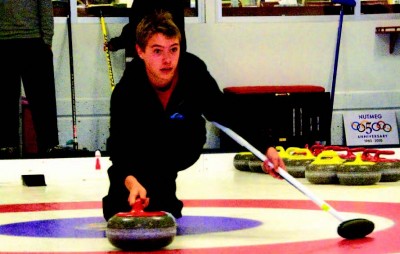
Americans have football, basketball, and baseball – three action packed, fast moving pastimes. However, every four years when the Winter Olympics comes around, people cannot help but become enthralled with the excruciatingly slow sport of curling.
“I was in Germany during the Winter Olympics and since all of the television was in German, I could only really watch the Olympics and curling was on, a lot,” Sarah Ressler ’12 said.
Ressler, a member of the Staples golf team, was also intrigued by the sport because of the similarities it has with golf.
“[I noticed that both sports] incorporate [strategies] such as touch, focus, and strategy,” Ressler said.
Curling involves two teams of four players each. The objective of the game is to slide 42-pound granite blocks across the ice, or curling sheet, into the target, or “house”, which is located on the far end of the ice. Each team gets eight granite blocks each, and the team that lands the most stones closest to the center of the target wins.
Excited by the sport, Ressler, along with her friend Marni Schulman ’12 now curl at the Nutmeg Curling Club located at the Wonderland of Ice in Bridgeport
Schulman who calls curling a “lost sport,” was intrigued by its ambiguity, and decided to pick it up because of its uniqueness.
Although the sport may be unique, it is not new or unknown to the rest of the world. According to the official website of the 2010 Winter Olympics in Vancouver, the game of curling is more than 500-years-old.
Curling, nicknamed “The Roaring Game” for the thunderous sounds the blocks make as they slide across the ice, originated in 16th century Scotland.
During this time period the game was played on frozen lochs and ponds. In 1998 curling was officially added to the Winter Olympics program.
Jack Gibson ’12 was also inspired by the Winter Olympics to give curling a go.
Gibson curled at the Nutmeg Curling Club with several of his friends who wanted to try the sport for fun.
“It was very entertaining and easier than it looks,” Gibson said.
Schulman agreed and noted that the ice sport only took her a “matter of minutes” to pick up.
Even though the sport may have come as a breeze to the novice curlers, Gibson, Ressler, and Schulman all agreed that curling is not a cakewalk.
“The hardest thing about curling [is] sweeping because it can be scary to run on the ice since you always have that fear in the back of your mind that you will fall,” Ressler said.
Schulman agreed that sweeping is the hardest curling move to make, whereas both Schulman and Ressler thought that the easiest part of the game was releasing the stone.
“It’s definitely a unique sport, so it was exciting because it was so unfamiliar to me. It isn’t that difficult to learn, but extremely hard to execute with precision,” Ressler said.
Ressler and Schulman have become interested and are looking into pursuing an official league. For Gibson, curling is now a lifetime sport he has acquired to play for fun.












































